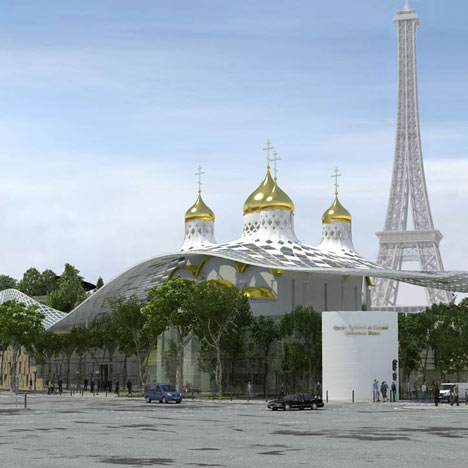
Cultural and Spiritual Russian Orthodox Center in Paris by Arch group and Sade Sarl
Russian architects Arch-group and French studio Sade Sarl last week won an international competition to design a Russian Orthodox church and cultural centre beside the Eiffel Tower in Paris.
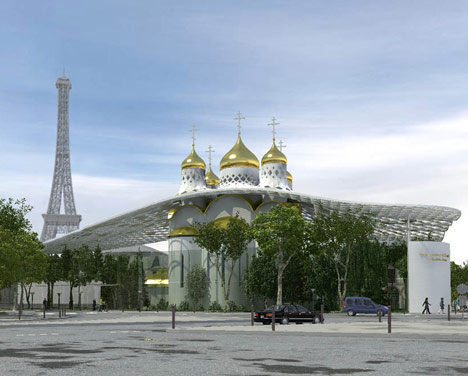
The Cultural and Spiritual Russian Orthodox Center will include a large public garden surrounded by a glass wall of multimedia screens.
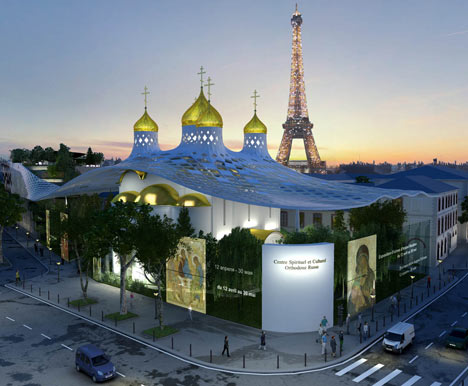
A glass canopy will swoop over part of the garden, joining the stone cultural centre and church with nine golden domes.
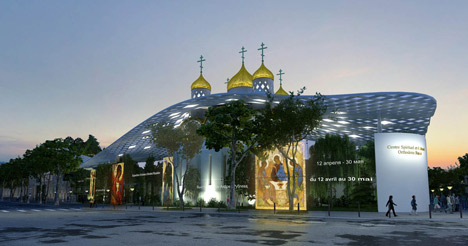
See also: Dezeen's top ten churches
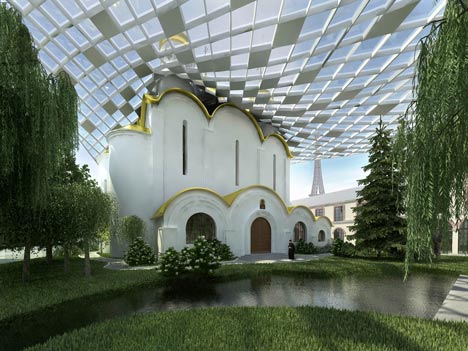
The information that follows is from Arch Group:
The Russian Orthodox culture and religion, which are based on spiritual traditions, are playing an extremely important part in Russia’s attempt to overcome its present difficulties and are a source of moral direction for a considerable part of the population. The task of creating a modern, positive, and open image of Russian Orthodoxy follows from the fact that knowledge of Russian Orthodox culture is essential for understanding and interacting with Russia. And yet Russian Orthodox culture is at the present time poorly represented in Europe. The creation of a Russian Orthodox cultural centre in Europe will help strengthen international relations and is of enormous importance from the point of view of education and culture. By making this cultural centre a combination of tradition and modernity it will be possible to attract visitors from all generations, including young people.
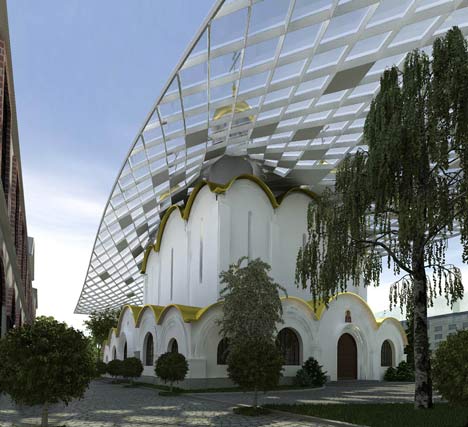
Urban planning
The complex in question is situated at the intersection of quai Branly and avenue Rapp, which together form place de la Résistance. The complex’s rear façade faces onto rue de l’Université. The site is located in the eastern corner of the large triangle formed by avenue Rapp, quai Branly, and avenue de la Bourdonnais. The site’s north-eastern corner looks out over place de la Résistance in front of Pont de l’Alma. This corner correlates with the corner of the building on the other side of the square, at the intersection of quai d’Orsay and avenue Bosquet.
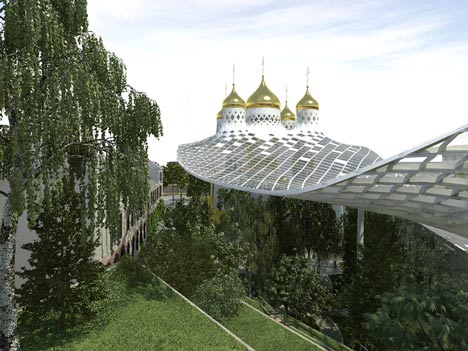
An important aspect from the point of view of urban planning is that the design project features an emphatic rounded ‘Parisian corner’ corresponding to the principles which have shaped the existing layout of the surrounding built-up area. This corner and the northern façade shape the view from Pont de l’Alma, which is an important and lively main road linking the 7th and 8th arrondissements.
The site’s northern façade faces quai Branly, which is part of the tourist walk from Notre Dame to the Eiffel Tower. The architectural design of the building’s north façade and its use of media screens are of especial importance given the intensity of traffic on Pont de l’Alma and the pedestrian flows along quai Branly.
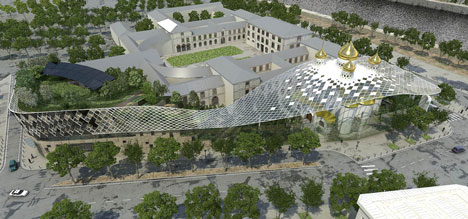
Click above for larger image
Directly abutting the complex on quai Branly is an old palace building. On the other side of the palace is a world-famous museum (designed by Jean Nouvel), which has a wall of glass facing the embankment and screening off its garden and Modernist multi-hued museum block. In this way, the palace is incorporated in the dialogue between two modern complexes framing it on either side.
One of the most important components of the design here proposed is the large garden, which occupies the entire site. This garden is open to the public, and in it stands the Russian Orthodox church. The axis of the church coincides with the axis of symmetry of the lateral façade of the palace. In this way, the proposed design not only brings a picturesque garden to the embankment, but visually liberates the side façade of the palace, which joins with the church in forming an axial, symmetrical composition of the kind that is traditional for the old centre of Paris.
The design involves the creation of a new internal alley on the site, running between the existing palace and the Russian Orthodox church. Entrances are likewise to be created on rue de l’Unviersité and avenue Rapp. The entrance from avenue Rapp is intended for people entering the church on festive occasions and for processions of the Cross.
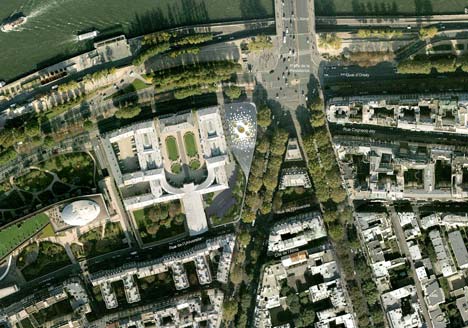
Click above for larger image
Architecture
General principles:
The principal architectural idea behind the complex is to employ traditional church architecture in a modern cultural and religious complex. The unifying element is a transparent canopy, which descends from the domes of the church, covers the garden, and bends around the reconstructed corner building. By linking all the parts of the complex, the canopy gives it integrality, reflecting the fact that religious and secular functions are here combined…. The integrality of the ensemble also makes it possible to meet urban-planning challenges and to recreate the corner of one of Paris’ central street blocks.
The entire look of the complex aims to create a positive, open image of Russian Orthodoxy – one that will make the latter attractive and interesting to parishioners and to inhabitants of and visitors to the city of Paris. The architecture of the complex should attract new people of all ages and kindle in them an interest in Russian spiritual culture.
As in traditional Christian church complexes, the entire area around the church is a garden with a perimeter wall. In the design here proposed, this boundary is more symbolic than real – since it consists of a glass wall made from coated glass of reduced reflectivity. This makes the complex open to the sun, air, and the gazes of people looking in. The glass wall is a media façade on which static and dynamic images may be displayed, together with announcements of forthcoming events at the cultural centre, exhibitions, religious holidays, images of icons, and so on. The project allows for the possibility of using innovative new-media ideas to create a ‘second’, interactive reality in both open and closed space, and to set up an interaction between holographic characters and objects and the real world, creating a new type of communication in real time. This generates enormous scope for putting together a large number of programmes for spiritual, cultural, and aesthetic development and for drawing the attention of people from different generations (and especially young people) to the activities of the centre.
The church is situated at the spot where the ribbon of the canopy and the ribbon of the garden, coming together in the corner building, divide in two as they approach the embankment.
Passing through the entire site is a new alley, which is paved with large slabs of stone with grass growing between them. This alley creates a through passageway from quai Branly to rue de l’Université, giving access to all parts of the cultural and religious complex – namely, the church, garden, and corner building.
The project uses three main materials – white stone for the church (symbolizing Russian tradition); Paris stone for the corner building; and glass for the canopy (symbolizing openness and protection at the same time).
The canopy covers the three main parts of the complex – the church, the garden (which occupies the entire site), and the reconstructed ‘Parisian’ corner building, which accommodates all the remaining functions.

Click above for larger image
The church:
In the centre of the site and in the centre of the garden, behind the glazed media façade overlooking the embankment and avenue Rapp, stands the Russian Orthodox church. The project envisages building the church in a style deriving from the 14th to 16th centuries as a pure and simple structure which will be especially clearly legible against the background of the side façade of the palace. The church faces strictly east, with a deviation of no more than 5 degrees.
The church has five domes and three naves and lateral sanctuaries. Its main volume conforms to the elongated proportions of the traditional church, but the floor area of the interior is approximately 400 m2 as a result of the expanded lower part. There is a possibility of creating a smaller, single-altar underground church (crypt).
The church is to be in the style of the 14th to 16th centuries and constructed of large slabs of white limestone specially imported for this purpose from Russia.
The main, western, entrance to the church is from the new alley. There are two additional entrances – on the south and north sides – which may be used on festive and ritual occasions. In front of the northern entrance, there is a small square in the garden where people may stand in front of the church on days when there is large-scale attendance. The northern entrance can also be used for the Procession of the Cross – which will enter the complex from avenue Rapp, go round the complex along the embankment, and return along the new alley.
The domes are to be constructed using a special technology which will give them a traditional appearance during the day, but allow a golden light to show through the paint at night.
All the drums of the church’s domes are glazed, allowing the interior of the church to be lit by soft and dispersed natural light during the daytime. The windows of the drums and of the walls of the church are designed in such a way as to avoid direct sunlight, especially near the ‘Royal Gates’.
The interior will have traditional wall paintings in the style of Andrey Rublev. The western sanctuary at the main entrance has a staircase leading down to the lower church. The choir is situated on the second tier on the western wall and is accessed via a small spiral staircase.
The main church has a maximum capacity of 600 persons, while the lower church can accommodate 400.
The church may be used for public events – and events of a cultural as well as religious nature, so as to stimulate interest in Russian Orthodox culture.
The garden:
The garden in our project has important symbolic significance. Thanks to the system of terraces and the green roof and terraces of the cultural centre building, the garden occupies the entire plot of land – starting from the embankment, continuing behind the church, and ascending the terraces of the corner ‘Parisian’ building to the bell-tower. The low bell-tower forms the highest point of the complex (with the exception of the domes); it stands in the garden, on the roof of the corner building.
The green terraces and roof, onto which there is a way out from both the residential floors and the cultural centre, will offer an unusual view of Paris and of the complex’s canopy and domes.
The lateral axis of the garden is formed by the absolutely straight line of the new alley, which is complemented by a romantic Russian garden on three levels.
Most of the plants in the garden are ‘Trinity greenery’ of the kind that is traditional in Russia – birch, spruce, maple, lime, and ash. This fits in with the fact that the church in the garden is dedicated to the Holy Trinity. Inside the internal radius of the white-stone wall in the corner facing Pont de l’Alma is a small lake with a gurgling spring and a small relaxation area shielded from noise and other people’s gazes.
On the corner of quai Branly and the new alley three existing trees are to be preserved. They will become an organic part of the garden, serving as a symbol of a tactful and caring attitude to the history of this site and of the city as a whole.

Click above for larger image
The cultural centre:
The project contains no separate building for the cultural centre: the entire complex under the canopy is a spiritual and cultural centre. The boundaries of this centre are the glass mediafacades facing quai Branly and avenue Rapp and the facades of the corner building. All the functional areas, including the conference hall, exhibition hall, and so on, come together in the reconstructed ‘Parisian’ building on the corner of rue de l’Université and avenue Rapp.
This kind of unification of secular, residential, and office functions, and of the seminary and parish rooms in a single building means that these spaces can be used with great flexibility in the future and with maximum rationality at the present time.
This building makes the entire complex seem to grow out of the historical flesh of Paris. Part of the façade of the reconstructed building on the edge of the plot will be preserved unmodified. It will gradually turn into a new, modern façade created from recycled blocks of stone taken from the facades of the building that has been dismantled on this site.
The part of the building which borders the garden will be partly taken apart. This will create a system of terraces descending from the green roof right into the garden. This greened cascade with its small picturesque staircases will create a continuous green band beginning at the embankment and ascending right to the roof of the building, where the low bell-tower stands.
The two top residential storeys are set back relative to the bottom storeys and ‘screened’ by a transparent glass-less mesh, the latter being what the canopy covering the garden turns into. The set-back walls and balconies of the residential storeys are greened.
In the depths of the plot, on the inner side of the corner building, two storeys are to be built onto the existing annex. This will give additional space for the use of the parish and seminary. The façade of this annex consists of narrow vertical screens arranged in such a way as to provide privacy and visual comfort in spite of the proximity of the palace.
The conference hall of the cultural centre is in the basement, under the garden. The entrance to it is from the main hall of the reconstructed building.
Inside, the building has an atrium stretching to its full height and admitting natural light to its basement level. Given the different functions that are to be accommodated on different floors, the perimeter of the atrium is to be glazed; this will ensure acoustic comfort and compliance with the French fire-safety regulations.
The central hall and atrium will contain the main staircase linking all the storeys. There are to be separate staircases for the two residential storeys. In this way, the different functional flows are to be divided, but in the event of fire there are sufficient evacuation routes from all storeys.
Functioning
The main entrances to the complex are on the new alley from quai Branly and rue de l’Université. An additional entrance from avenue Rapp may be used during mass events and festive occasions. To provide for such cases, there is a small square in front of the southern entrance to take pressure off the main alley and accommodate a large number of visitors and parishioners beside the church. Processions of the Cross may pass through this square.
Access for automobiles, including to the 15 parking spaces, is from rue de l’Université, through two pairs of gates that form a security buffer. Festive and ritual processions may drive up to the church along the new alley, directly from the embankment and, driving right through the complex, emerge onto rue de l’Université.

Click above for larger image
On entering the complex from the embankment, visitors find themselves in a garden that ascends in front of them up a series of terraces. Advancing along the picturesque alley alongside the historical façade of the palace, they will approach the church. If they do not intend to visit the church itself, they may simply stroll through the garden, sit by the lake and spring, or ascend, in the company of a member of the complex’s staff, through the terraces to the bell-tower in the garden on the roof of the corner building in order to enjoy a fine view of the complex and of Paris to boot. Continuing on their way, they may enter the cultural centre and the central hall – in order to gain access to the offices, seminary, parish rooms, or residential storeys.
On reaching rue de l’Université, the new alley finishes in a covered section giving access to the cultural centre and conference hall. This zone may be closed off on its outside in order to restrict access to the complex, or may be screened off from the church by a sliding wall; in this way flows of visitors to the cultural and religious parts of the complex may be separated.
Entering the corner building from rue de l’Université, visitors find themselves in the central hall and atrium. On this floor there are administrative spaces and rooms belonging to the parish. The central main staircase and central pair of lifts give access to the office storey and the seminary.
Descending, visitors come to a green recreational area with natural daylight entering through a skylight in the roof. This floor contains the parish archives and dining room. All the kitchen facilities serving the cultural centre, dining room, and residential floors have been reduced to a kitchen block in the basement; this block delivers food to individual floors using various lifts. The atrium supplies the kitchen with natural light.
In the basement is a gallery linking the crypt with the atrium of the corner building. Abutting this gallery are technical spaces accommodating the complex’s utilities systems.
In addition to the central lifts and main staircase, there are two independent vertical communication shafts ascending from the central atrium. These are separate blocks of lifts and staircases for the seminarists living on the fourth floor and for the priests living on the fifth. To provide for emergencies, the doors are to be fitted with anti-panic locks and it will be possible for all floors to use these staircases simultaneously as escape routes.
The residential floor occupied by the seminarists will have a small common dining room with a way out onto the terraces.
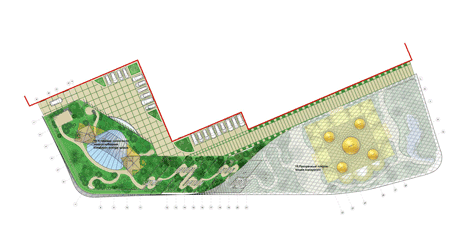
Click above for larger image
Construction
Basement:
Between the church and the corner building there will be a basement level accommodating the cultural centre’s conference hall. The church is also to have a basement level. These spaces will be joined together into a single system, which will also incorporate the basement of the existing building. This basement will be slightly expanded to accommodate technical spaces used in the operation of the building’s utilities systems. French engineering companies are some of the best at designing basement structures in areas with high levels of ground water. From the structural point of view, a watertight concrete basin will be built on this spot. In the church this basin will be clad with full-size blocks of white stone. No underground works are to be carried out in the area nearest the River Seine.
The church:
With five domes and three naves, this traditional-style church is made from massive blocks of white limestone. The exterior walls are one metre thick. Inside, the vaulting is supported by four massive round columns of stone. The construction is traditional, being based on similar churches from the 14th to 16th centuries.
The cultural centre:
The existing building on the corner of rue de l’Université and avenue Rapp is to be preserved; this will involve partial use of both the building’s structural system and its existing facades. The building’s right-hand wing will be partially dismantled in order to create terraces. The two-storey addition at the rear will be made of reinforced-concrete and metal structures. The roof and terraces will have a layer of earth between 0.3 and 1 metre thick as a bed for trees and bushes. The new façade of the corner building will be clad in stone blocks taken from the dismantled neighbouring Meteo France building. The existing floor panels will be cut to create an atrium stretching the full height of the building.
The garden:
The garden is divided into three parts: a lower garden around the church, a terraced garden in the partially dismantled building, and an upper garden on the roof of the ‘Université’ building. All three gardens will be watered using rainwater collected in cisterns. All the gardens have lighting and sound provided by a modular installation giving adjustable (partial or full) lighting and sound.
Fence:
The complex’s fence is a glass wall consisting of two panes of glass one on top of another. Each pane is 4 x 4 metres, the maximum size made by Saint Gobain, the leading world producer of architectural glazing. The entire construction is supported by glass piers positioned on the inner side of the fence. Use is to be made of a special coated and non-reflective glass. Between the panels of glass are gaps, and the entire wall is considerably lower than the canopy. The piers at intervals of 4 metres and the gaps between the glass panels improve the wall’s acoustics, preventing sound waves spreading along its surface, which extends for 200 metres along avenue Rapp.
The canopy:
The structural rhombic mesh of the canopy is supported by the church and four tree-like columns standing in the garden. In those places where the structure kinks, it is reinforced by internal hawsers. When it reaches the corner building, the canopy turns into the mesh of the second façade; here, however, it is without glass. The basic element of the structure is a rhombus based on a rib approximately 5 x 30 cm high. The rib of the mesh is triangular and narrows towards the bottom. This makes it possible to bring more light into the garden under the canopy and to impart to the structure a light, lacelike appearance as of something in flight. This is a lightweight and transparent structure that admits sufficient light for the trees in the garden, while also standing up well to atmospheric conditions.
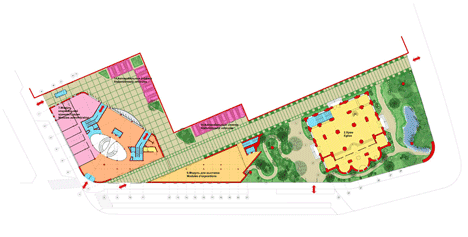
Click above for larger image
Sustainability
The main technology proposed by our French engineers is the creation of a self-washing roof. The water used to wash the roofing subsequently helps to heat the building. The essence of this proposal is that the exterior of the entire canopy is to be covered with a thin film of flowing water which is heated by the sun as it flows. This warmed water is then collected in underground reservoirs that preserve heat in the same way that a thermos does, and is used to warm the building. This will help save energy during operation of the cultural centre. Another proposal is to install a large number of photovoltaic and thermal panels on the mesh of the second façade.
A pleasant environment for residents of and visitors to the complex, as for passers-by, will be created by the large volume of vegetation. The garden in effect has a floor area equal to the area of the site; this will improve the environment in this district as a whole.
The recycling of the façade stone of the dismantled buildings, the working of this stone on site, and the partial use of the corner building will reduce the amount of construction materials required to build the complex and will dramatically cut use of transport during construction. Overall, this will reduce harmful emissions attributable to the building of the complex.
To look further ahead, the prevalence of natural materials (glass, stone) used in construction of the complex will have a favourable effect on the complex’s functioning and on its environmental impact on the district and arrondissement.
Cultural and Spiritual Russian Orthodox Center in Paris
Architects:
Manuel Nunez-Yanovsky,
Mikhail Krymov,
Alexey Goryainov
Client: Russian government
4500 sq.m..
2011 г.
See also:
.
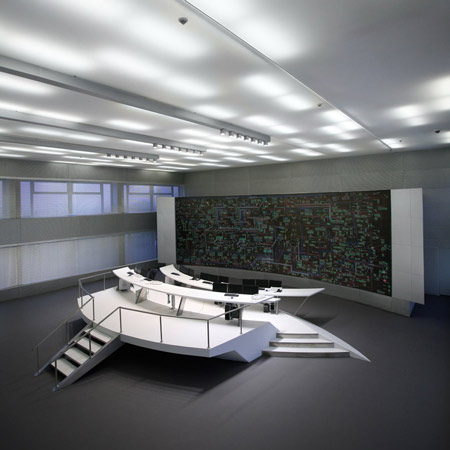 |
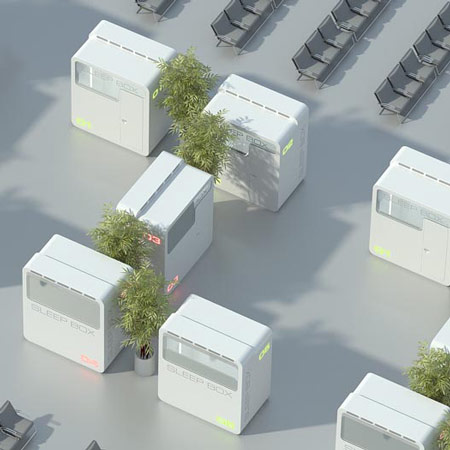 |
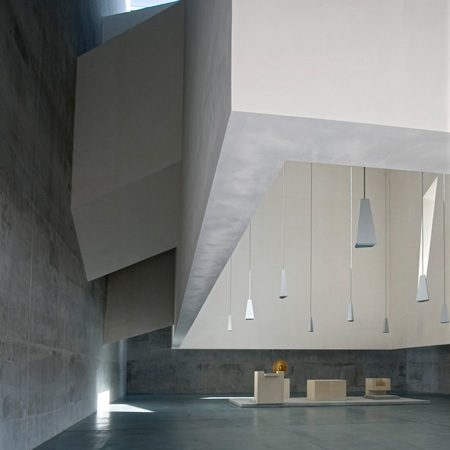 |
| Moscow electricity control centre by Arch group |
Sleepbox by Arch group |
Dezeen’s top ten: churches |